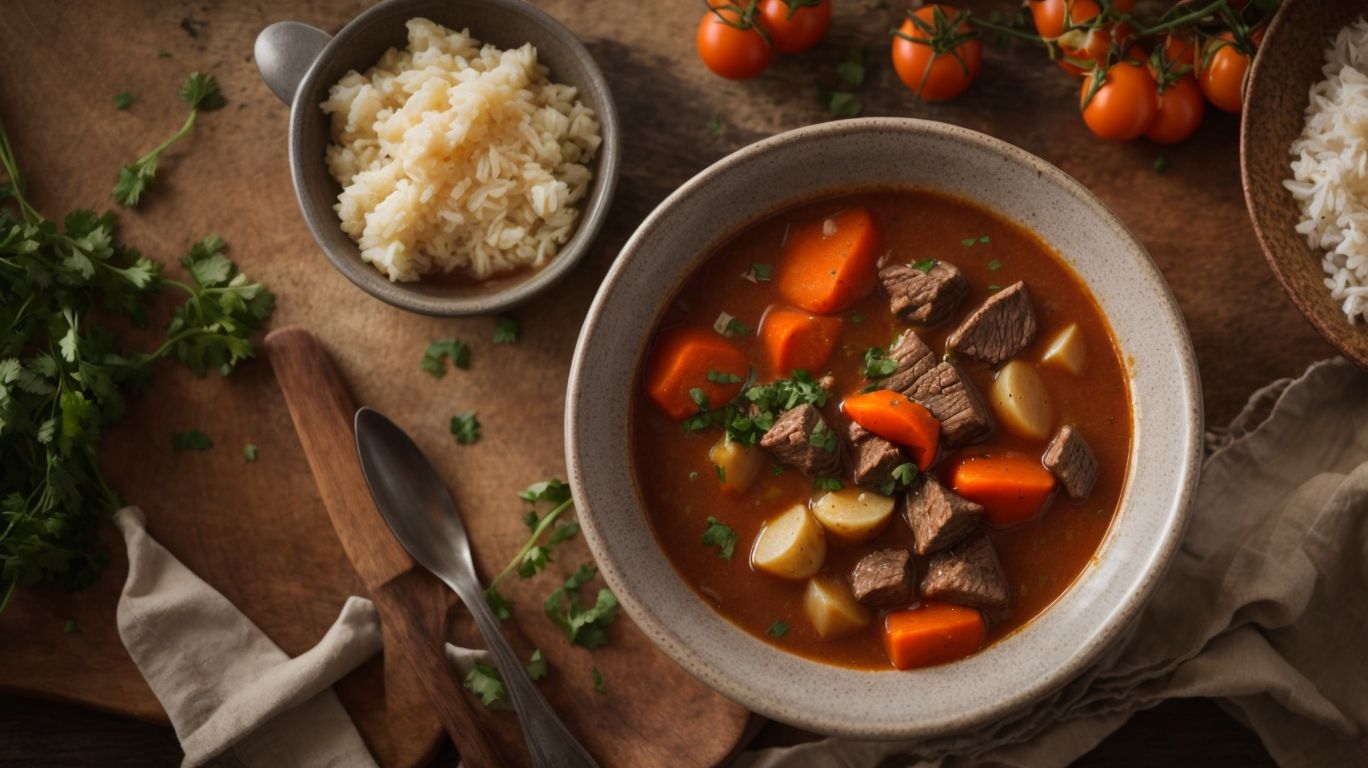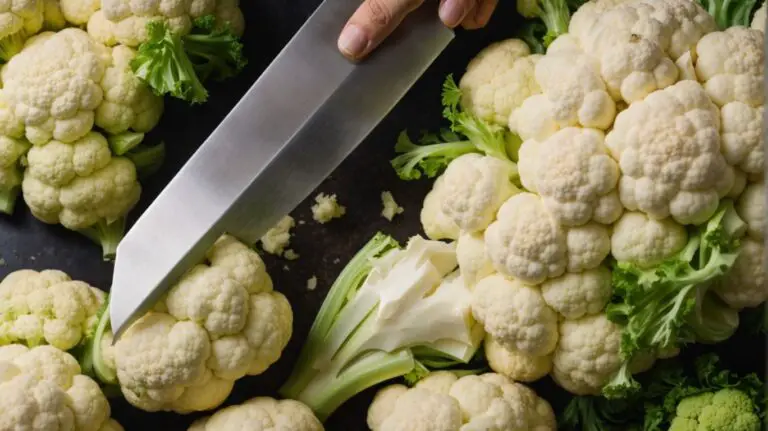How to Cook Beef Stew for Ugali?
Are you ready to tantalize your taste buds with a hearty meal that will warm your soul?
We explore the perfect pairing of Beef Stew and Ugali, a traditional Kenyan dish. From marinating the beef to simmering the stew to cooking the Ugali to perfection, we guide you through every step of the process.
Get ready to impress your friends and family with this delicious meal that is sure to become a favorite in your recipe collection. Stay tuned for tips on serving and storing leftovers!
Key Takeaways:
Ingredients for Beef Stew
To create a flavorful Beef Stew, you will need a combination of ingredients including beef, onions, carrots, tomatoes, garlic, stock cube, salt, pepper, and water.
Each ingredient plays a crucial role in building the layers of flavor that make a Beef Stew irresistible. The beef, typically stewing beef such as chuck roast, adds depth and richness to the dish. Onions, when sautéed, provide a sweet and savory base, enhancing the overall taste. Carrots contribute a touch of natural sweetness and a vibrant color, while tomatoes offer acidity and brightness. Garlic, with its pungent aroma, elevates the savory notes.
The stock cube, usually beef or vegetable, intensifies the savory essence, while salt and pepper season the stew to perfection. Water is essential to create a hearty broth that binds all the flavors together, ensuring a comforting and fulfilling dish.
Beef
Beef is the star ingredient in any Beef Stew recipe, providing the hearty and rich flavors that define this classic dish.
In terms of selecting the right cut of beef for your stew, it’s essential to opt for tougher, less expensive cuts that are perfect for slow cooking.
Common choices include chuck, brisket, and round cuts, known for their marbling and connective tissues that break down during the cooking process, resulting in meltingly tender meat.
To achieve that desirable tenderness, it’s crucial to cook your stew over low heat for an extended period of time, allowing the collagen in the beef to dissolve and impart richness to the dish.
Vegetables (Carrots, Potatoes, Onions, Tomatoes)
A medley of vegetables including carrots, potatoes, onions, and tomatoes add texture, flavor, and nutrients to the Beef Stew, creating a balanced and wholesome meal.
Carrots bring a subtle sweetness and vibrant color to the stew, while potatoes provide a hearty and filling element. Onions contribute a rich savory depth to the broth, enhancing the overall umami taste of the dish. Tomatoes add acidity and a touch of brightness, balancing the flavors. Each vegetable plays a crucial role in enriching the stew’s taste profile, offering a harmonious blend of textures and flavors.
Spices (Garlic, Paprika, Thyme, Bay Leaves)
Spices such as garlic, paprika, thyme, and bay leaves infuse the Beef Stew with aromatic flavors, elevating the overall taste profile of the dish.
These spices not only add depth but also create a symphony of flavors that meld together harmoniously in the pot.
- Garlic brings its pungent sweetness,
- paprika lends a smoky richness,
- thyme offers earthiness, and
- bay leaves provide a subtle herbal note that ties everything together.
When combined thoughtfully, these spices transform a simple stew into a culinary masterpiece. The key lies in balancing these flavors to achieve a harmonious blend – a pinch of this, a dash of that, and a sprinkle of something unexpected can take your stew from ordinary to extraordinary.
Liquid (Beef Broth, Water, Red Wine)
The inclusion of liquid components such as beef broth, water, and red wine helps to create a rich and flavorful base for the Beef Stew, ensuring a delicious and well-balanced dish.
Each liquid plays a key role in stewing:
- Beef broth adds depth and umami
- Water helps to create the necessary volume while allowing other ingredients to shine
- Red wine introduces a complex and fruity note
When selecting liquids, consider your desired flavor profile – opt for a rich beef broth for a hearty stew, use red wine for a sophisticated touch, or experiment with vegetable broth for a lighter and vegetarian-friendly version.
To enhance the dish, consider incorporating tomato paste for a touch of acidity or a splash of balsamic vinegar for a deeper flavor profile.
Ingredients for Ugali
Ugali, a staple dish, requires simple ingredients like maize flour, water, and salt to create a satisfying and versatile accompaniment to various dishes.
Maize flour serves as the foundation of Ugali, imparting a hearty texture and earthy flavor to the dish. It acts as the main source of carbohydrates, making Ugali a filling and energy-rich meal choice.
Water is essential for binding the maize flour into a cohesive mixture during the cooking process, ensuring a smooth and lump-free consistency. The addition of salt enhances the overall taste profile of Ugali, balancing out the flavors and bringing a savory note to complement other dishes.
Achieving the right consistency in Ugali is crucial, as it should be firm enough to hold its shape when served but still soft and easy to eat.
Maize Flour
Maize flour serves as the primary ingredient in Ugali, providing the base for this traditional African dish known for its simplicity and versatility.
When preparing Ugali, maize flour is mixed with boiling water or milk, creating a thick, dough-like consistency that is essential to achieve the desired texture. The key to perfect Ugali lies in achieving just the right balance between maize flour and water, ensuring a smooth texture without lumps. As the mixture cooks, constant stirring helps to prevent any clumping and ensures uniform cooking. The result is a delicious and hearty staple that is often enjoyed with various stews, sauces, or meats.
Water
Water is a crucial component in making Ugali, as it helps to bind the maize flour and achieve the desired consistency for this popular dish.
When preparing Ugali, the amount of water used plays a significant role in determining the final texture. The right balance is key; too much water can result in a thin, watery consistency, while too little can lead to a dry and crumbly texture.
Traditional methods involve slowly adding water to the maize flour while continuously stirring to avoid lumps and ensure even absorption.
Variations in water quantity can also impact the cooking time, with more water requiring longer cooking to reach the desired thickness. Experimenting with water amounts allows for customization based on personal preference.
Salt
A pinch of salt is essential in Ugali preparation to enhance the flavor profile of this simple yet satisfying dish that complements a wide range of main courses.
Adding salt to Ugali not only brings out the natural flavors of the maize flour but also balances the overall taste, making it more palatable. Salt acts as a flavor enhancer, intensifying the other ingredients present in the dish. It’s important to sprinkle salt gradually while stirring the mixture to ensure even distribution and avoid clumping. Striking the right balance with salt can elevate the entire dining experience, turning a basic meal into a delightful culinary adventure.
Preparing the Beef Stew
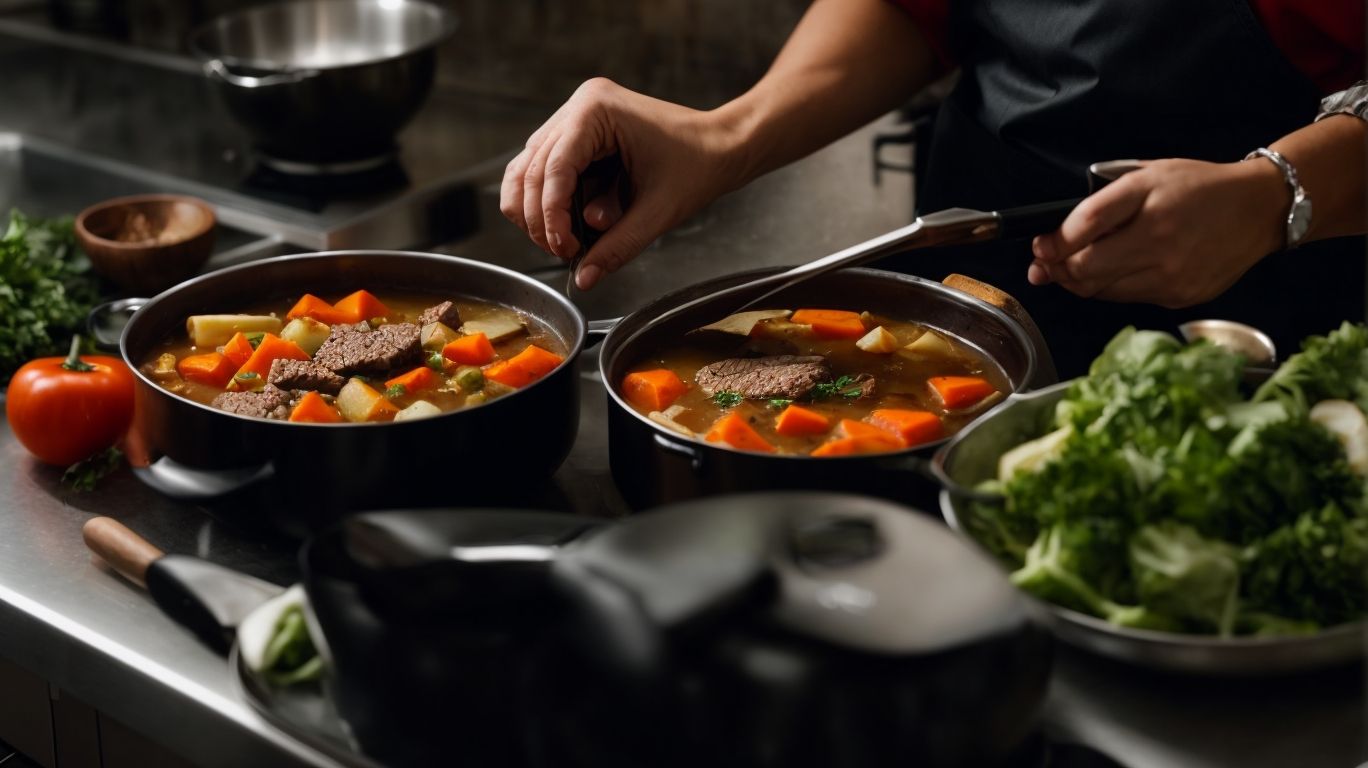
Credits: Poormet.Com – Roger Green
The process of preparing Beef Stew involves marinating the beef, searing it to lock in flavors, sautéing vegetables, adding spices and liquid, simmering the stew to tender perfection, and thickening the sauce for a satisfying consistency.
Marinating the beef enhances its tenderness and flavor. A mixture of red wine, garlic, herbs, and a splash of vinegar make an excellent marinade. Let the beef sit in the marinade for at least a few hours, or ideally overnight, in the refrigerator for optimal infusion of flavors.
Once marinated, remove the beef from the marinade, pat it dry, and sear it in a hot pan to create a caramelized crust. This step helps to seal in the juices, ensuring a succulent and moist texture in the final stew.
In a separate pot, sauté a medley of onions, carrots, and celery to create the aromatic base of the stew. Adding a pinch of salt at this stage helps to draw out the natural juices of the vegetables, enhancing the overall depth of flavor.
Marinate the Beef
Marinating the beef in a blend of spices, seasonings, and liquids helps to tenderize the meat and infuse it with complex flavors before cooking in the stew.
In terms of marinating beef for stew, the duration plays a crucial role in how well the flavors develop. For optimal results, it is recommended to marinate the beef for at least 4 to 12 hours to allow the ingredients to penetrate the meat fully.
Key ingredients like soy sauce, Worcestershire sauce, garlic, and herbs are often used in marinades to enhance the taste of the beef. These elements not only add depth to the flavor but also contribute to tenderizing the meat, resulting in a more succulent final dish.
Sear the Beef
Searing the beef in a hot pan caramelizes the outer layer, enhancing the overall flavor and texture of the meat in the Beef Stew.
When searing beef for a stew, it’s crucial to preheat the pan properly to ensure an even sear. Heat the pan over medium-high heat until it’s hot but not smoking. High-quality beef cuts like chuck or brisket work best for stew and benefit greatly from searing.
The duration of searing varies depending on the thickness of the beef. Typically, sear each side for 2-3 minutes until a crust forms. This quick process locks in the juices, resulting in tender, flavorful meat.
The caramelization achieved through searing adds rich depth to the stew’s flavor profile. The Maillard reaction that occurs during searing creates complex, savory notes that elevate the overall taste experience.
Saute the Vegetables
Sautéing the vegetables in the beef drippings adds depth of flavor and aroma to the Beef Stew, creating a savory base for the dish.
When selecting vegetables for sautéing in your stew, opt for hearty options like carrots, celery, and onions, which release rich flavors when cooked slowly.
- To ensure even cooking, chop the vegetables into uniform sizes.
- Heat a skillet over medium-high heat and add a bit of oil to prevent sticking.
- When the oil is shimmering, add the vegetables in batches, allowing them to caramelize and develop a sweet, earthy taste.
- Enhance the flavors further by seasoning with herbs like thyme and rosemary or spices such as paprika and cumin.
- Stir occasionally to prevent burning and sweat the vegetables until they are slightly translucent and tender.
Add Spices and Liquid
Adding a blend of spices and liquid components like beef broth and red wine enriches the Beef Stew with layers of flavor, enhancing its overall taste profile.
In terms of spice incorporation in stew, the key is to strike a delicate balance between different flavors. Spices like paprika, thyme, and bay leaves can add depth and complexity to the stew. Meanwhile, liquid additions, such as wine or broth, not only provide moisture but also infuse the dish with rich flavors.
Proportioning the liquids correctly is vital to achieving the desired consistency. A general rule of thumb is to use a ratio of 1:1 for meat to liquid. This ratio can vary depending on personal preference and the desired thickness of the stew.
When incorporating spices, consider layering them throughout the cooking process to allow their flavors to develop fully. Toasting whole spices before grinding them can also intensify their flavor profile, adding a unique dimension to the stew.
Simmer and Thicken the Stew
Simmering the stew over low heat allows the flavors to meld together while thickening the sauce to a rich and satisfying consistency that coats the tender meat and vegetables.
During the simmering process, the natural juices of the ingredients infuse with the seasonings, creating a flavorful base for the stew. By maintaining a gentle simmer, the meats break down slowly, becoming fork-tender, while the vegetables soften just enough to retain their texture.
Simmering also helps to intensify the aromas and tastes, as the essential oils from the herbs and spices release gradually, enriching the overall dish. This slow cooking method allows the ingredients to amalgamate into a cohesive blend, enhancing every spoonful with a depth of flavor.
Cooking the Ugali
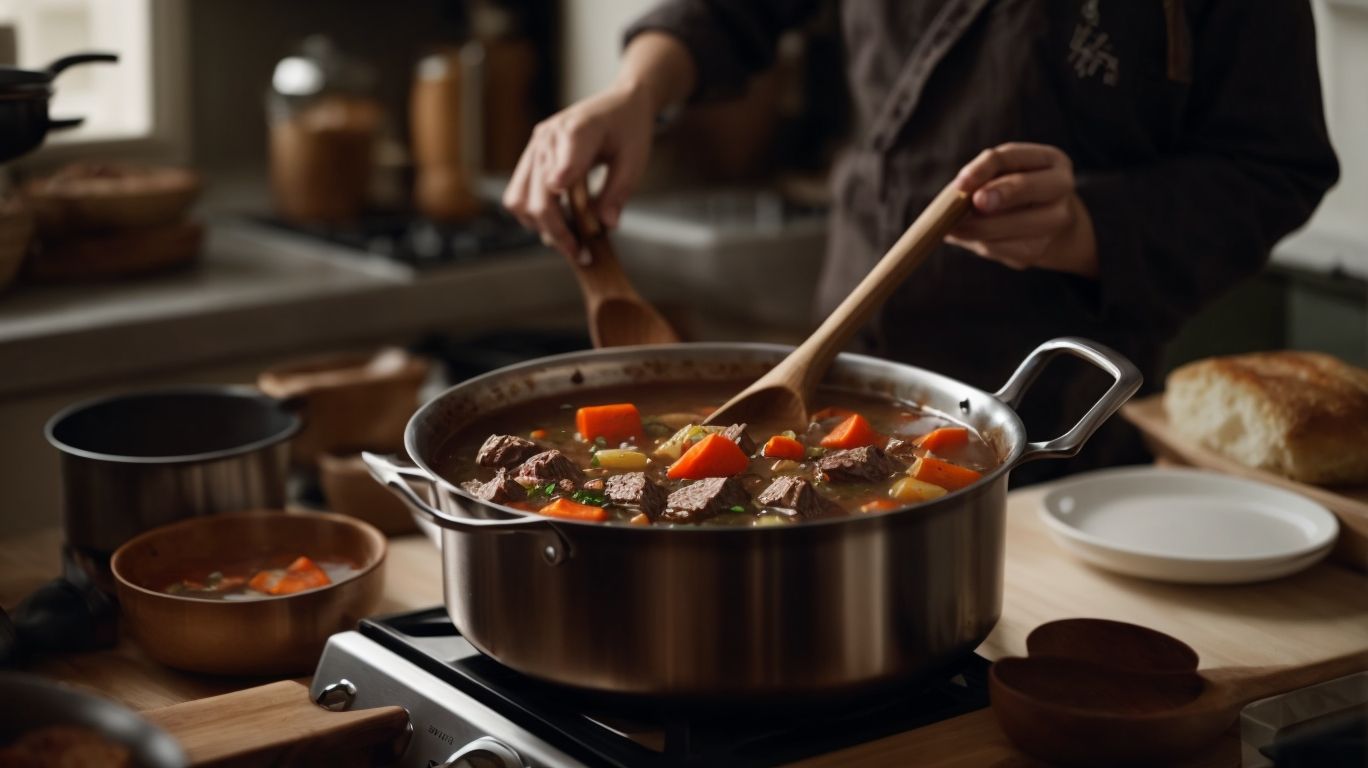
Credits: Poormet.Com – Adam Davis
Cooking Ugali involves boiling water, adding maize flour and salt, stirring continuously until thickened, and cooking to achieve the desired consistency for this staple dish.
To start the process, you need to bring the water to a rolling boil in a sufuria or cooking pot. The key to achieving the right texture lies in the gradual addition of the maize flour while vigorously stirring to prevent lumps from forming. Consistency is crucial; the Ugali should be firm enough to hold its shape but still tender. The traditional method involves turning the Ugali out onto a plate then using a wet spoon or fingers to shape it into a mound, ready to be served with your favorite accompaniment.
Boil Water
Boiling water is the first step in making Ugali, as it creates a hot base for mixing with maize flour and salt to achieve the desired texture and consistency.
Properly boiling water is crucial in Ugali preparation. The water’s temperature needs to be high enough to fully cook the maize flour, ensuring the Ugali reaches the right thickness and stickiness. Generally, it is recommended to use a 1:3 ratio of maize flour to water to get the perfect Ugali consistency. Boil the water first before gradually adding the maize flour while stirring continuously.
Add Maize Flour and Salt
Incorporating maize flour and salt into the boiling water forms the foundational mixture for Ugali, requiring continuous stirring to prevent lumps and achieve a smooth consistency.
As the maize flour is slowly added to the boiling water, it is crucial to maintain a steady and consistent stirring motion. This helps in evenly dispersing the flour particles throughout the mixture, avoiding clumps and ensuring a homogeneous texture. Sprinkling the salt at this stage ensures that it is well-distributed, enhancing the overall flavor profile of the Ugali. The continuous stirring also prevents the mixture from sticking to the pot’s bottom and burning, leading to a perfectly cooked and delicious dish.
Stir and Cook Until Thickened
Stirring the Ugali mixture continuously and cooking until thickened are essential steps to achieve the desired texture and consistency characteristic of this beloved African dish.
During the cooking process, it’s crucial to pay attention to the mixture’s consistency. A common test to ensure the Ugali is cooked properly is to observe if it pulls away cleanly from the sides of the pot when stirred. This indicates that the maize flour has absorbed the water and started to form a cohesive mass.
Adjustments can be made by adding more flour if the mixture is too thin or adding water if it’s too thick. The cooking time varies depending on the quantity prepared; usually, it takes about 10-15 minutes for the mixture to thicken.
Serving and Presentation
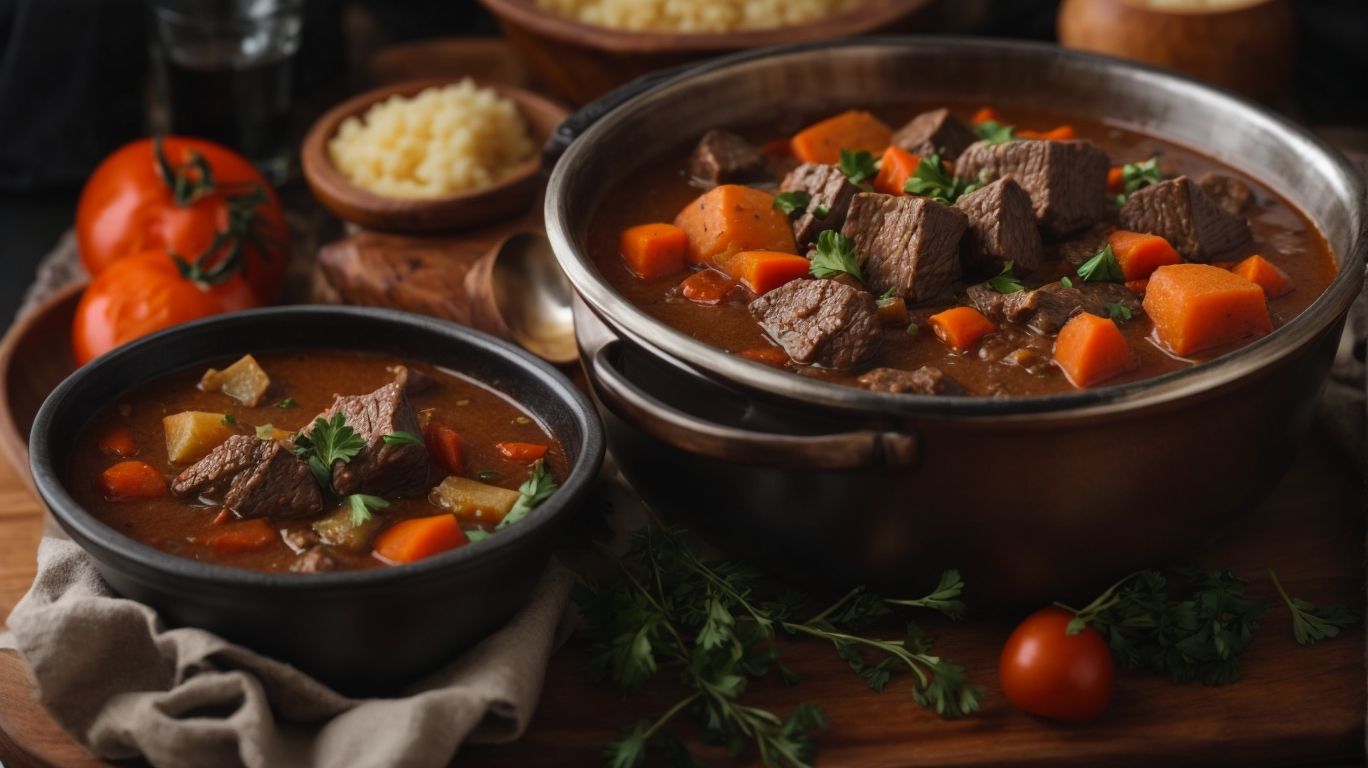
Credits: Poormet.Com – Ethan Walker
The final touch in preparing Beef Stew and Ugali involves plating the dishes with care, garnishing with fresh herbs, and providing tips for pairing and storing leftovers for maximum enjoyment.
When serving Beef Stew and Ugali, consider using shallow bowls for a rustic presentation or opt for elegant white plates for a more formal appeal. Sprinkle chopped parsley or thyme leaves on top for a burst of color and flavor. To elevate the dish further, drizzle a swirl of olive oil or a dollop of sour cream on the stew just before serving. For an exquisite pairing, serve the hearty stew with a side of steamed vegetables or a crisp mixed green salad.
Plate the Stew and Ugali
Plating the Beef Stew and Ugali thoughtfully enhances the visual appeal of the dish, creating an inviting presentation that complements the flavors and aromas.
When plating, consider using white plates to provide a contrast that makes the hearty stew and soft Ugali pop. Remember to strategically place the tender pieces of beef atop the creamy Ugali, creating layers of textures and colors. Playing with heights by stacking the Ugali on the side or topping the stew with a sprinkle of fresh herbs can add an element of sophistication to the presentation.
Garnish with Fresh Herbs
Garnishing the Beef Stew and Ugali with fresh herbs adds a burst of color, freshness, and additional flavor dimensions to the dish, elevating its visual and gustatory appeal.
In terms of selecting the fresh herbs for garnishing, it is important to choose ones that complement the flavors of the beef stew and Ugali. Popular options include parsley, chives, cilantro, and basil. These herbs not only bring vibrancy to the presentation but also infuse the dish with their unique aromas and tastes.
For placement, consider scattering chopped herbs over the top of the stew and around the edges of the Ugali. This distribution ensures that every bite contains a pop of herbaceous goodness. Mixing in some whole leaves for a decorative touch can further enhance the visual appeal.
Flavor pairings play a crucial role in garnishing. For instance, pairing parsley with beef stew adds a fresh, earthy note, while sprinkling cilantro on Ugali imparts a citrusy undertone. Experimenting with different herb combinations can help find the perfect balance of flavors for your dish.
Tips for Pairing and Storing Leftovers
Providing tips on pairing Beef Stew and Ugali with complementary dishes and storing leftovers properly ensures a delightful dining experience and minimizes food wastage.
In terms of pairing Beef Stew and Ugali, consider red wine such as a Merlot or Shiraz for a rich and robust flavor combination. Sides like garlic bread or creamy mashed potatoes can complement the hearty flavors of the stew and provide a well-rounded meal.
When storing leftovers, ensure they are placed in airtight containers to maintain freshness and prevent any odors from seeping into the food. To preserve the flavors, consider adding a splash of fresh herbs or a squeeze of lemon juice before reheating.
Frequently Asked Questions
1. What is beef stew and how is it different from regular stew?
Beef stew is a hearty dish that typically consists of beef cubes, vegetables, and broth. The main difference from regular stew is that beef stew specifically uses beef as the protein, whereas regular stew can use any type of meat or even be meatless.
2. What is the best type of beef to use for beef stew?
The best type of beef to use for beef stew is a tough, lean cut such as chuck or round steak. These cuts are ideal for slow cooking and will become tender and flavorful in the stew.
3. Can I make beef stew in a slow cooker?
Yes, beef stew can be made in a slow cooker. Simply follow the same steps as you would for stovetop cooking, and cook on low heat for 6-8 hours or high heat for 4-6 hours.
4. How do I make beef stew for Ugali?
To make beef stew for Ugali, start by browning the beef in a pot on the stovetop. Then, add in your desired vegetables and broth. Let the stew simmer for at least an hour before serving over Ugali.
5. Can I add other ingredients to my beef stew for extra flavor?
Yes, you can add other ingredients such as red wine, herbs, or spices to enhance the flavor of your beef stew. Just be sure to adjust the amounts accordingly and taste as you go.
6. What is the best way to serve beef stew for Ugali?
The best way to serve beef stew for Ugali is to spoon the stew over a bed of cooked Ugali. You can also serve it with a side of steamed vegetables or crusty bread for a complete meal.

